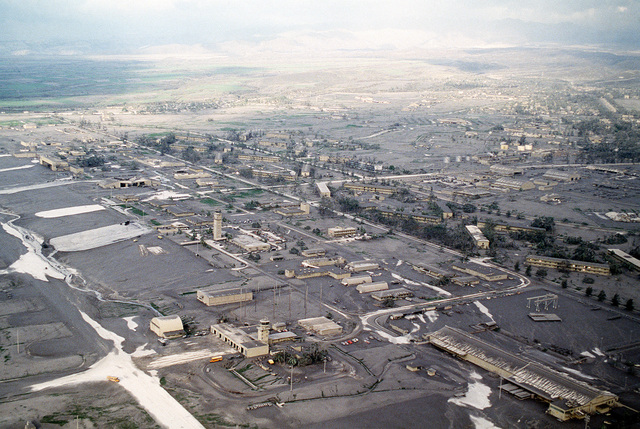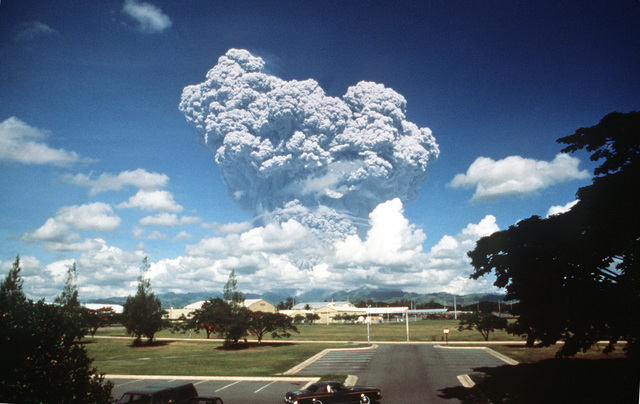The Cataclysmic Eruption of Mount Pinatubo on June 12, 1991
June 12, 1991 is a date that will forever be etched in Philippine history.
On this day, Mount Pinatubo, a volcano that had been dormant for over 500 years, roared back to life in a cataclysmic eruption.
The eruption was the second-largest volcanic eruption of the 20th century, and by far the largest to affect a densely populated area.
The Reawakening of a Sleeping Giant

Signs of Mount Pinatubo’s reawakening began in July 1990, when a magnitude 7.8 earthquake struck about 60 miles northeast of the volcano. This was followed by small steam explosions and earthquakes near the volcano in March-April 1991.
Scientists from the Philippine Institute of Volcanology and Seismology (PHIVOLCS) and the U.S. Geological Survey (USGS) began monitoring the volcano closely.
In early June, activity ramped up dramatically. On June 7, the first magma reached the surface, forming a lava dome. Sulfur dioxide emissions increased from 500 tons/day on May 13 to 5,000 tons/day by May 28. This massive increase indicated a rising column of fresh magma beneath the volcano. By early June, thousands of small earthquakes were occurring daily.
A Spectacular Eruption on Philippine Independence Day
June 12, 1991 was Philippine Independence Day. On this historic day, Mount Pinatubo began its climactic eruptions. At 1:42 PM, the volcano exploded, sending an ash column 19 km (12 mi) into the atmosphere. Additional explosions occurred overnight and into June 13. Seismic activity became intense.
The situation intensified on June 15 when highly gas-charged magma reached the surface. Mount Pinatubo exploded in a cataclysmic eruption that ejected over 1 cubic mile (5 cubic km) of material. The ash cloud soared 22 miles (35 km) into the air and grew to over 300 miles (500 km) wide, turning day into night across central Luzon. Ash fell as far as the Indian Ocean, and satellites tracked the cloud several times around the globe.
Massive pyroclastic flows roared down the flanks of Pinatubo at speeds up to 100 mph (160 km/h). These searing avalanches of hot ash, gas and pumice buried river valleys up to 660 ft (200 m) deep. The eruption removed so much magma that the summit collapsed to form a caldera 1.6 miles (2.5 km) across.
Hazardous Aftermath: Lahars and Disease
The eruption’s impacts were compounded by the arrival of Typhoon Yunya (Diding) on June 15. Heavy rains from the typhoon mixed with the volcanic ash to form massive lahars (volcanic mudflows).
For years after the eruption, lahars continued to flow down river valleys, destroying everything in their path. By 1997, more than 0.7 cubic miles (3 cubic km) of lahar debris had buried hundreds of square miles of land.
The lahars destroyed homes, farms, bridges, and roads. Thousands of roofs collapsed under the weight of wet ash. Over 840 people died, mostly from collapsing roofs and sickness in evacuation camps. About 1 million people were directly impacted, with 100,000 left homeless. Agriculture and infrastructure suffered damages of $700 million.
A Devastating Blow to the U.S. Military

The eruption dealt a major blow to U.S. military forces in the Philippines. The U.S. operated Clark Air Base and Subic Bay Naval Station, both within 20 miles of Pinatubo. Clark Air Base was heavily damaged by ash, with buildings and aircraft destroyed. Ash and lahar flows swept through the base.
The U.S. Air Force evacuated its personnel and as many local residents as possible. But many had to ride out the eruption, sheltering in place. In the end, the eruption forced the closure and eventual abandonment of Clark Air Base after almost a century of U.S. presence.
A Volcano Reawakens After 500 Years
Mount Pinatubo’s 1991 eruption ended a 500-year slumber. Prior to this, the volcano’s last major eruptions were around 500, 3500 and 5500 years ago based on radiocarbon dating. Much of the surrounding plains were built by deposits from these ancient eruptions. The reawakening in 1991 shows that even long-dormant volcanoes can roar back to life.
The cataclysmic nature of the eruption is attributable to the long repose time. Magma slowly accumulated beneath the volcano over hundreds of years, allowing a huge amount of gas-rich magma to build up.
This set the stage for highly explosive eruptions once the magma started rising to the surface in 1991.

Lessons Learned and Lives Saved
While the 1991 Pinatubo eruption was devastating, it could have been much worse if not for the effective eruption forecasting and evacuations. Close monitoring by PHIVOLCS and USGS scientists enabled the prediction of increasing activity and major eruptions. Evacuations were carried out in stages, with 60,000 people evacuated from within 20 miles of the volcano before the June 15 eruption.
It is estimated that the forecasts and evacuations saved at least 5,000 lives and $250 million in property. The 1991 eruption demonstrated the critical importance of volcano monitoring, eruption forecasting, and cooperation between scientists and public officials. These lessons have since been applied at volcanoes around the world.
Global Cooling from an Eruption
The Pinatubo eruption also had global impacts. The ash cloud contained 20 million tons of sulfur dioxide, which spread worldwide and caused global temperatures to drop by about 1°F (0.5°C) in 1991-1993. This volcanic cooling effect temporarily masked some of the global warming trend.
The eruption provided a “natural experiment” to study how Earth’s climate responds to changes in atmospheric aerosols. The data collected has helped refine climate models and our understanding of the complex interplay between volcanoes and climate.
A Disaster That Reshaped a Region
The 1991 Pinatubo eruption forever changed the landscape and lives of those in central Luzon. About 20,000 indigenous Aeta people who lived on the volcano’s slopes were completely displaced. Over 200,000 people in the lowlands had to evacuate.
In the aftermath, the government launched a major rehabilitation effort to address the damage and displaced populations. This included constructing dikes and dams to control lahars, building new homes and infrastructure, and providing aid and services to those impacted. The eruption’s effects are still being felt over 30 years later.
Watch this video:
Conclusion
The June 12-15, 1991 eruption of Mount Pinatubo was a landmark event in Philippine history and global volcanology. It tragically claimed hundreds of lives and displaced hundreds of thousands. The ash and lahar damaged homes, farms, infrastructure and military bases. Successful eruption forecasting and evacuations saved thousands of lives that would have otherwise been lost.
The eruption was a stern reminder of the power of volcanoes, even those that have lain dormant for centuries. It demonstrated the importance of monitoring volcanoes and heeding the warnings of scientists.
The data collected advanced our understanding of explosive eruptions and their global impacts. While the 1991 disaster brought great hardship, it also brought forth resilience, innovation, and valuable knowledge to help us live more safely with volcanoes.




Your comment is awaiting moderation.
hydroxychloroquine and covid hydroxychloroquine malaria